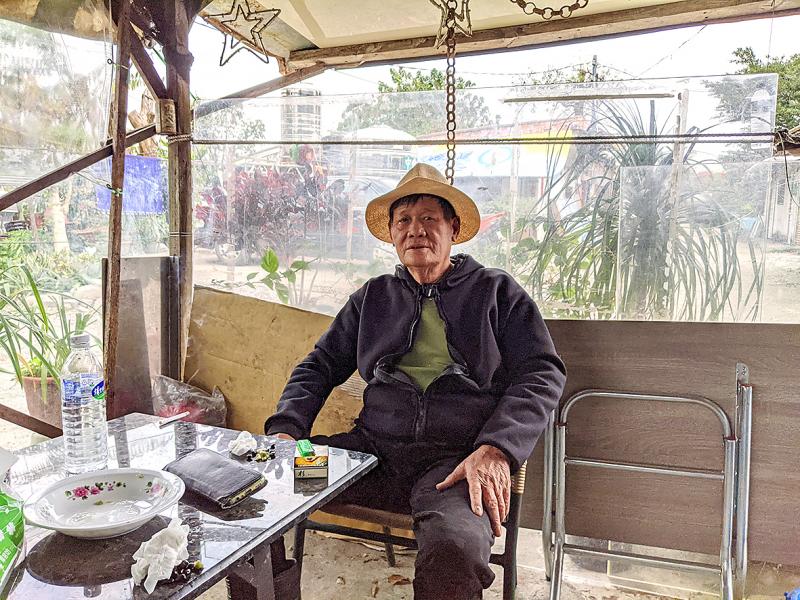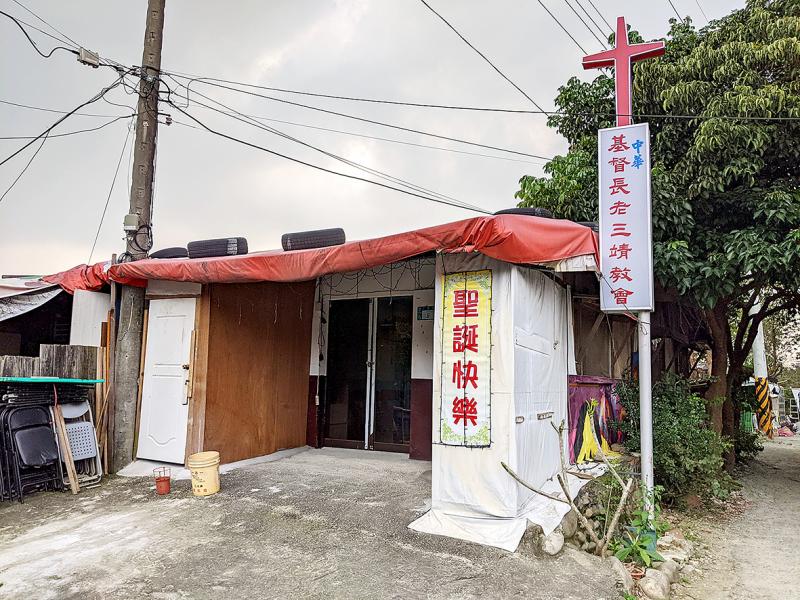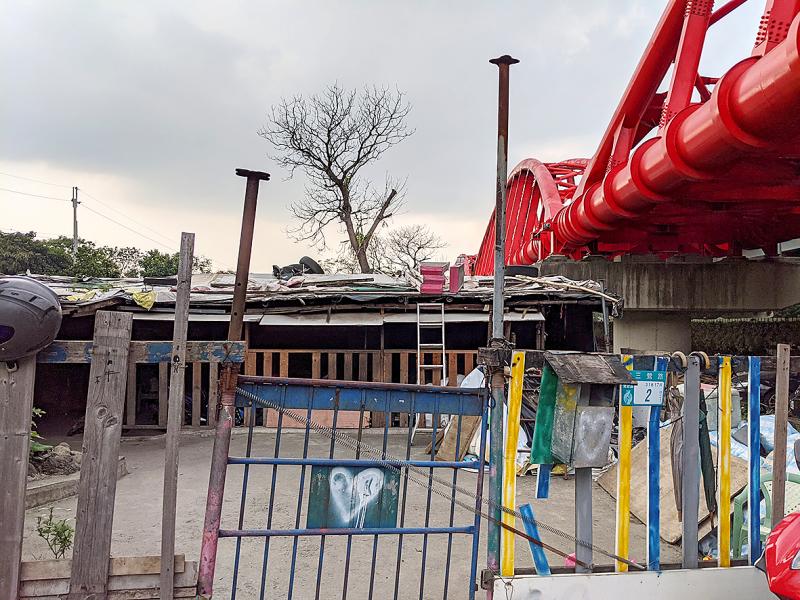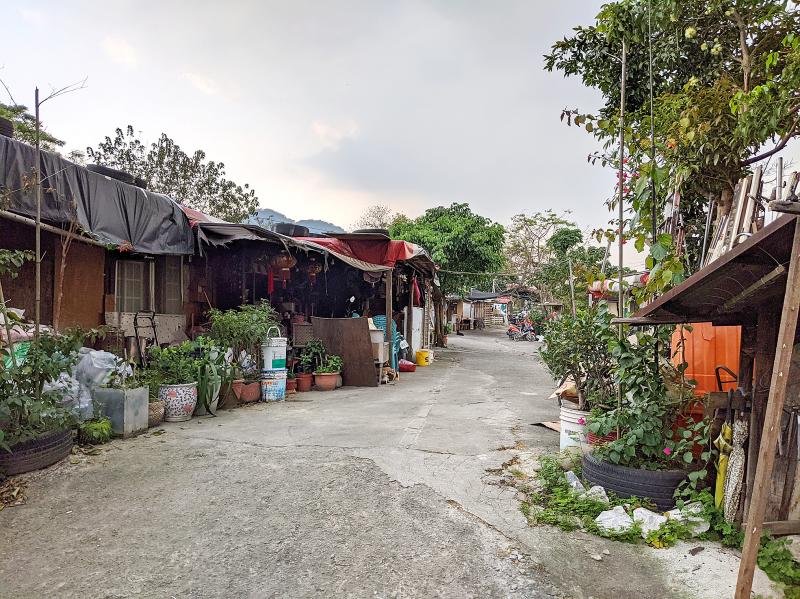A look of firmness set on Chief Kalow’s (蘇萬法) face as he looks over his village, the afternoon sun illuminating his wrinkled face and glassy eyes.
Though the sounds of people chatting in Amis could place Nanjing (南靖) somewhere in Hualien or Taitung counties, its 50 households live along the south bank of the Dahan River (大漢溪), next to the Sanying Bridge connecting Sansia (三峽) and Yingge (鶯歌) districts in New Taipei City.
The story of how a group of Amis people reconstructed the form of their traditional communities in a metropolitan area illustrates the urbanization of indigenous people. According to the Council of Indigenous Peoples, as of January, over 47 percent of indigenous people live in urban areas, a population that is disproportionately young. Beyond this, however, Nanjing is proof that for indigenous communities, even in democratic and diverse Taiwan, the struggle for autonomy and against assimilation continues.

Photo: Itamar Waksman
THE GREAT MIGRATION
According to Hafay Pikar, an Amis researcher and activist, indigenous individuals began migrating to urban centers in the 1960s as Taiwan began to rapidly industrialize. The increase in the cost of living in indigenous communities, driven by factors like new taxes and school fees and combined with the underdevelopment of these regions, drove them to seek work in the urban centers of economic growth.
Additionally, the Chinese Nationalist Party’s (KMT) assimilation policies encouraged these people to migrate, viewing it as a way to force them to integrate into Han society. With the government’s support, businessmen — either themselves or through intermediaries — would visit communities on the east coast seeking new workers.

Photo: Itamar Waksman
“The purpose of these policies was to take indigenous people from their communities to urban areas so that they could become a usable part of the labor force,” Pikar tells the Taipei Times.
Businessmen would often seek individuals from specific communities due to their unique skills, like the Amis and their fishing tradition. Once settled in a new area, they would attract other members from their original indigenous community.
Kalow understands the story well. He originally came to what is today New Taipei City in the 1980s to work in carpentry, like most men in Nanjing. He settled in Sansia, where a number of other Amis from his region were living. In the early 2000s, as the economy faltered, he found it harder to afford housing. By 2008, he gave up and constructed his own house along Dahan River, on a plot of land owned by the city. Other Amis people had periodically lived on the land since the 1970s, and there was already another indigenous community named Sanying (三鶯) on the river’s north bank. More households followed, and by 2009 the community chose Kalow as its chief and registered with the Indigenous Peoples Department of New Taipei City.

Photo: Itamar Waksman
Kalow says that, lacking assistance from the government, his only means of survival was to reconstruct a community similar to the one he had left — one centered on interpersonal relationships and communal living.
“We came here for our children, to give them a future where they could grow up together,” he says.
Today, Nanjing is a group of roughly 50 structures made out of wood and tarpaulin, mostly connected by dirt roads and surrounded with fruit and vegetable gardens. In the summer the interior of these homes are sweltering, and in the winter they are frigid. The community is not connected to the city’s gas or water infrastructure, and electricity began to be supplied only three years after its formation.

Photo: Itamar Waksman
Kalow says government policy is at the root of these conditions. The New Taipei City government, which owns the land the community is built on, requires that all structures be exclusively built with wood and tarps. More permanent materials such as cement, bricks or sheet metal, are forbidden. Their use has resulted in structures being demolished without warning in the past.
“It’s useless to rely on the government. Officials and legislators don’t care about us. All we can do is rely on ourselves to protect our own people,” Kalow says.
RESETTLEMENT AND CONFLICT
In 2008, the government completed the Lung En Pu (隆恩埔) public housing estate, with the intent of resettling the residents of Sanying and Nanjing. Most of Sanying’s residents went, but most of Nanching’s stayed put.
“The city government doesn’t want the residents of these communities to live there long-term. They hope to force these communities to integrate into Han society,” says Yang Chia-hsien (楊佳賢), executive director of the New Taipei City Le Wo Community Service Association (新北市樂窩社區服務協會), which serves members of urban indigenous communities throughout New Taipei City.
“The community is a natural formation, but once residents move to public housing, the social fabric disintegrates, creating many social problems,” Yang says.
The residents of Sanying that remained in the old community entered into conflict with the government, and their homes were periodically demolished. For the residents of Nanjing, it was clear that a similar fate was possible.
In 2016, the government agreed to resettle the remainder of Sanying in a new residential area near its original location. But Yang says many residents are still unhappy. The community is split and the overbearing management from officials has caused distrust.
Yang says that the government has taken autonomy away from these communities. In the new Sanying, because the government owns the land, it requires that the community gain approval before making any large changes, like additions to buildings or creating new community projects. But for the residents, who are used to freedom in their villages, a space where the state is often far away, these matters are to be solved by the community. He adds that it has created a sentiment among residents that they’ve been stripped of their self-determination, a sensitive issue for indigenous communities.
Yang says this has been done on purpose.
“It’s impossible that indigenous elites in the government don’t understand the social structures of indigenous communities and that they didn’t communicate this with their Han peers. It must be because the state wants these people to live just like everyone else,” he said.
STAYING PUT
Chief Kalow says he and the residents will not go, adding that a deal like Sanying’s is untenable. Sanying’s residents had to take out a loan according to its agreement with the government, and its lease expires in 20 years. This prospective debt and future uncertainty is unacceptable to the residents of Nanjing.
“There’s no way we can leave this place,” Kalow says. “We spent so much time, money and energy developing this land. The government likes to say that the indigenous are Taiwan’s owners. Isn’t this also a piece of Taiwan? ”
For Kalow, legalizing Nanjing and other communities is a step towards a truly pluralistic Taiwan.
“Don’t treat us like lower-class citizens. Indigenous, Han, Pingpu — we must all be treated equally so that we can share this place. Only then can we have a splendid society,” he says.

Exceptions to the rule are sometimes revealing. For a brief few years, there was an emerging ideological split between the Democratic Progressive Party (DPP) and Chinese Nationalist Party (KMT) that appeared to be pushing the DPP in a direction that would be considered more liberal, and the KMT more conservative. In the previous column, “The KMT-DPP’s bureaucrat-led developmental state” (Dec. 11, page 12), we examined how Taiwan’s democratic system developed, and how both the two main parties largely accepted a similar consensus on how Taiwan should be run domestically and did not split along the left-right lines more familiar in

As I finally slid into the warm embrace of the hot, clifftop pool, it was a serene moment of reflection. The sound of the river reflected off the cave walls, the white of our camping lights reflected off the dark, shimmering surface of the water, and I reflected on how fortunate I was to be here. After all, the beautiful walk through narrow canyons that had brought us here had been inaccessible for five years — and will be again soon. The day had started at the Huisun Forest Area (惠蓀林場), at the end of Nantou County Route 80, north and east

Specialty sandwiches loaded with the contents of an entire charcuterie board, overflowing with sauces, creams and all manner of creative add-ons, is perhaps one of the biggest global food trends of this year. From London to New York, lines form down the block for mortadella, burrata, pistachio and more stuffed between slices of fresh sourdough, rye or focaccia. To try the trend in Taipei, Munchies Mafia is for sure the spot — could this be the best sandwich in town? Carlos from Spain and Sergio from Mexico opened this spot just seven months ago. The two met working in the

This month the government ordered a one-year block of Xiaohongshu (小紅書) or Rednote, a Chinese social media platform with more than 3 million users in Taiwan. The government pointed to widespread fraud activity on the platform, along with cybersecurity failures. Officials said that they had reached out to the company and asked it to change. However, they received no response. The pro-China parties, the Chinese Nationalist Party (KMT) and Taiwan People’s Party (TPP), immediately swung into action, denouncing the ban as an attack on free speech. This “free speech” claim was then echoed by the People’s Republic of China (PRC),